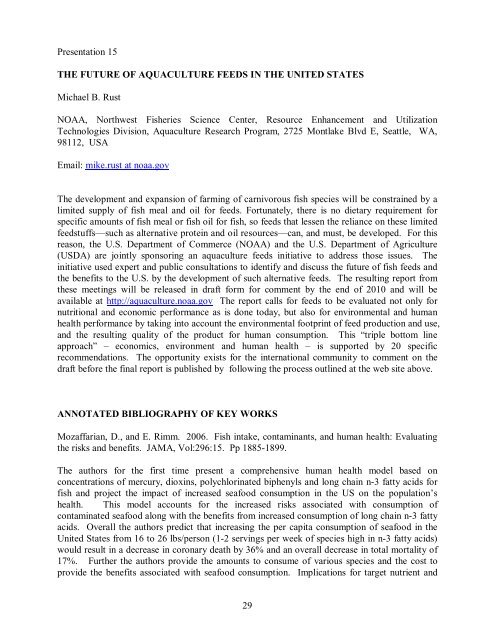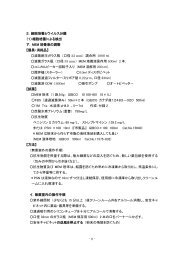Program and Abstracts(PDF)
Program and Abstracts(PDF)
Program and Abstracts(PDF)
You also want an ePaper? Increase the reach of your titles
YUMPU automatically turns print PDFs into web optimized ePapers that Google loves.
Presentation 15<br />
THE FUTURE OF AQUACULTURE FEEDS IN THE UNITED STATES<br />
Michael B. Rust<br />
NOAA, Northwest Fisheries Science Center, Resource Enhancement <strong>and</strong> Utilization<br />
Technologies Division, Aquaculture Research <strong>Program</strong>, 2725 Montlake Blvd E, Seattle, WA,<br />
98112, USA<br />
Email: mike.rust at noaa.gov<br />
The development <strong>and</strong> expansion of farming of carnivorous fish species will be constrained by a<br />
limited supply of fish meal <strong>and</strong> oil for feeds. Fortunately, there is no dietary requirement for<br />
specific amounts of fish meal or fish oil for fish, so feeds that lessen the reliance on these limited<br />
feedstuffs—such as alternative protein <strong>and</strong> oil resources—can, <strong>and</strong> must, be developed. For this<br />
reason, the U.S. Department of Commerce (NOAA) <strong>and</strong> the U.S. Department of Agriculture<br />
(USDA) are jointly sponsoring an aquaculture feeds initiative to address those issues. The<br />
initiative used expert <strong>and</strong> public consultations to identify <strong>and</strong> discuss the future of fish feeds <strong>and</strong><br />
the benefits to the U.S. by the development of such alternative feeds. The resulting report from<br />
these meetings will be released in draft form for comment by the end of 2010 <strong>and</strong> will be<br />
available at http://aquaculture.noaa.gov The report calls for feeds to be evaluated not only for<br />
nutritional <strong>and</strong> economic performance as is done today, but also for environmental <strong>and</strong> human<br />
health performance by taking into account the environmental footprint of feed production <strong>and</strong> use,<br />
<strong>and</strong> the resulting quality of the product for human consumption. This “triple bottom line<br />
approach” – economics, environment <strong>and</strong> human health – is supported by 20 specific<br />
recommendations. The opportunity exists for the international community to comment on the<br />
draft before the final report is published by following the process outlined at the web site above.<br />
ANNOTATED BIBLIOGRAPHY OF KEY WORKS<br />
Mozaffarian, D., <strong>and</strong> E. Rimm. 2006. Fish intake, contaminants, <strong>and</strong> human health: Evaluating<br />
the risks <strong>and</strong> benefits. JAMA, Vol:296:15. Pp 1885-1899.<br />
The authors for the first time present a comprehensive human health model based on<br />
concentrations of mercury, dioxins, polychlorinated biphenyls <strong>and</strong> long chain n-3 fatty acids for<br />
fish <strong>and</strong> project the impact of increased seafood consumption in the US on the population’s<br />
health. This model accounts for the increased risks associated with consumption of<br />
contaminated seafood along with the benefits from increased consumption of long chain n-3 fatty<br />
acids. Overall the authors predict that increasing the per capita consumption of seafood in the<br />
United States from 16 to 26 lbs/person (1-2 servings per week of species high in n-3 fatty acids)<br />
would result in a decrease in coronary death by 36% <strong>and</strong> an overall decrease in total mortality of<br />
17%. Further the authors provide the amounts to consume of various species <strong>and</strong> the cost to<br />
provide the benefits associated with seafood consumption. Implications for target nutrient <strong>and</strong><br />
29



